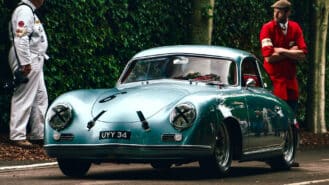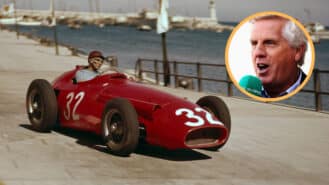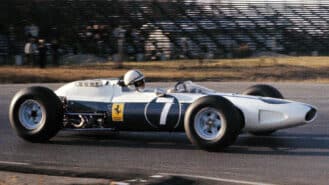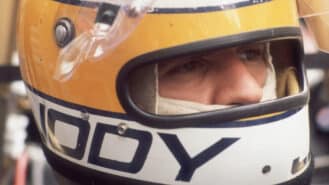
Denis Jenkinson's Porsche 356 roars again at Goodwood
Six decades after Motor Sport's famous continental correspondent Denis Jenkinson ran his Porsche 356 across Europe, it's now racing again following a long and careful restoration
A series taken from the 164-page Motor Sport special Great Racing Cars, which is available to buy here
To buy the lead image click here.
From the editor Damien Smith
How would you define a ‘great’ racing car? Race wins and championship titles are an obvious place to start – and admittedly, when we began the process of rounding up the ‘voices’ to fill this special magazine, published by the team behind Motor Sport, we had in mind the likes of the Lotus 72, Ferrari F2004, Porsche 917, Audi R10 and so on.
But as the interviews of familiar racing figures began, we realised greatness is often a very personal thing. Naturally, most – but not all – would pick cars they had experienced first-hand, as a driver, designer, engineer or team boss. And on occasion the cars that stood out in their minds as ‘great’ weren’t necessarily so in the grand scheme of history. That’s why you’ll find a Minardi here among Formula 1 cars from Lotus, Williams and McLaren.
Unexpected? Certainly. Wrong? Not to the man who chose it.
As the interviews accumulated, our magazine took on a life of its own, full of personal anecdotes about the myriad cars that made careers. Some of those we spoke to, such as Mario Andretti and Dan Gurney, couldn’t be tied to a single choice from multi-faceted lives at the wheel. Such heroes have earned the right to choose an F1, sports and Indycar, so we allowed them more than one bite.
Others refused to be confined by category. Hence the short ‘Odd ’n Sods’ chapter on cars that, by and large, are mere footnotes in lower divisions of racing lore.
Thus there is nothing definitive about the selection listed herein. Then again, there’s no claim that this compilation offers the ‘Greatest Racing Cars’ of history. It’s much more personal than that, much more quirky – and all the better for it.
For every Lotus 72 or Ford Escort Mk2 that tugs an emotional cord, there will also be a litany of Hawkes, Van Diemens, Pallisers, Royales and suchlike, fragments of an age when the world – and Britain in particular – was ripe with racing artisans, small enterprises building competition cars for an almost entirely free market. And then one-make racing’s invention snuffed most of them out. Many of our interviewees made fond reference to the cottage-industry stepping stones that helped launch their careers, and a select few put them top of their list…
1973
Merlyn MK11
David Kennedy
FF1600 champion, British F1 runner-up, Mazda endurance stalwart
Merlyn isn’t particularly widely known as a marque today, but that Mk11A was my second racing car and enabled me to understand the dynamics of driving – something with which I’d previously struggled.
I took it to the Bishopscourt circuit, a converted airfield with lots of fast, fourth-gear corners, and could suddenly see what an older driver had meant when he described my previous Lotus 51 as a ‘bucket of crap’.
I thought the Lotus was a normal racing car, but it turned out to have seized rear shocks, toe-in on one wheel but toe-out on the other and so on. It hadn’t been an ideal way to cut my teeth, so I stepped in to a front-running, second-hand Merlyn and it was just perfectly balanced. I’ve driven lots of racing cars but can’t think of any other that had the same neutral handling, with a touch of understeer just slightly moving to oversteer at corner exits. It enabled me to run at the front of the field against some of the latest kit, even though the car was perceived at the time as being of ancient vintage.
One Kirkistown race stands out, when I outbraked all the leading runners at the end of a long straight then threw the car sideways to get through. Not fully understanding the mechanics of racing, I hadn’t twigged that you needed to exit a corner quickly to be fast along the next straight. I just assumed my engine was useless! I did eventually work out that you needed to get the power on early.
My performances earned me the Star of the Year award, a first tick of acknowledgement, so my heart goes out to Merlyn.
1968
Ferrari Dino 166 F2
Andrea de Adamich
GP, sports and saloon star of the ’60s & ’70s
I raced an incredible number of cars, 43 to be precise, and I won in 13 of those, but this is the one I love more than any other. I signed for Ferrari in September 1967, dealing personally with Enzo Ferrari, without any lawyers, and it was a big thing for my career. Every racing driver loves a winning car, of course, but for me the Dino F2 is a special one.
I had been out of racing for eight months after my big crash at Brands Hatch in 1968, but at the end of the year I won the Temporada Championship in Argentina with my dear Ferrari Dino. I loved the car then, and I love it now. When I look at the pictures of the Temporada, beating Jochen Rindt in the third race there, I remember the excitement, the adrenaline of winning again. It was so good to prove that I was still quick, and competitive, after such a long time in convalescence after the crash at Brands.
The Dino was an easy car to drive, especially on the fast circuits and in the fast corners. The car gave me a lot of confidence, it had a very good feeling, and the chassis responded very well to any changes in the balance. The rear wing, mounted centrally on the engine, was very efficient, giving lots of downforce. This I did not expect because it was quite a small wing, but it was good aerodynamically and helped me a lot to find the perfect balance for my kind of driving.
The Dino always had some understeer, in fast and slow corners. I liked this, however, because after my crash at Brands Hatch the understeer gave me a very safe feeling in the car, and more confidence to be fast.
It was nice to be back in the F2 Dino at Fiorano for Ferrari’s 60th anniversary and it brought back many happy memories.
1983
Van Diemen RF83
John Booth
Serial FF1600 front-runner, Marussia F1 team principal
It wasn’t the best-looking Formula Ford car of all time, but I won 23 races that season – including the Champion of Champions event at Brands Hatch, which brought all the leading regional drivers together for an end-of-season one-off. Despite nursing a slipped disc, I won from about eighth or ninth on the grid. I think that race is on YouTube somewhere, with Murray Walker commentating: ‘There’s John Butcher Booth – and we call him that because he is a butcher…’
When I started out in 1979, I knew nothing at all about cars. I was a butcher and my chief mechanics were my brother-in-law and a mate who was a heating engineer.
By 1983 we’d probably learned a bit about the game: we had a good car with a good engine and knew how to look after it, so everything just came together. I think the RF82 was probably a nicer car to drive, but you remember the wins, don’t you?
1978
Chevron B42
Derek Daly
Former F1 driver, 49 GP starts
My favourite race car would be a Chevron B42 Formula 2 car with a 2-litre Hart engine in 1978. At Mugello that year I won a race against the March-BMW factory team with Bruno Giacomelli, Marc Surer and Manfred Winkelhock. My Chevron was almost a match for the BMWs. It wasn’t the fastest car but I could pound over the kerbs and arrive at a corner sideways and knew exactly what the car was going to do.
At Mugello I took the lead at the first corner and all three factory BMW cars hounded me for every single lap, but I managed to win. It was one of those great times. We had a great sponsor in ICI and the car was three different shades of green. Mugello was such a wonderful place and we won unexpectedly because the Hart engine wasn’t a match for the BMW. The headline in Motoring News said ‘Daly beats the Marches’ because it was so unusual.
The following week we had the engine rebuilt and Brian Hart wrote on each of the four exhaust ports, ‘Same again please DD’. We went to Vallelunga and Giacomelli was leading in the factory March, but he had some sort of radiator problem and with two laps to go I caught him and passed him and won again. So we won two races in a row and were leading the championship.
That car became one of my favourites, because of the way you could drive racing cars in the old days. You could pound over the kerbs and go faster. You could mash the power and get it sideways and go faster. It was the end of that era and one of the last cars you could drive that way. It was right before the ground-effect era where you had to be completely smooth. It was also the last car Derek Bennett designed, so it was perfect that I was able to win a couple of races in that car for him.

Six decades after Motor Sport's famous continental correspondent Denis Jenkinson ran his Porsche 356 across Europe, it's now racing again following a long and careful restoration

Voice of 90’s motor racing is completing project to revive hidden gems of motor sport film and television.

Ferrari's F1 car is set to feature a 'blue livery' at the 2024 Miami GP – we look back on the other times Maranello cars haven't run in red

Think of the great Formula 1 champions and Jody Scheckter is unlikely to feature. But, writes Matt Bishop, the 1979 title-winner deserves more acclaim for a career in which he was once the best driver, bar none